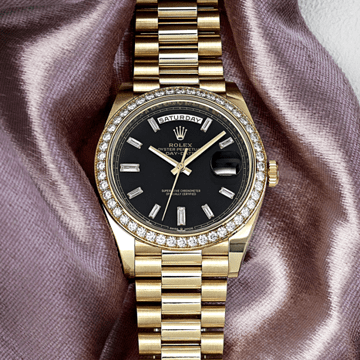Audemars Piguet Royal Oak Perpetual Calendar
Audemars Piguet Royal Oak Perpetual Calendar – The Art of Complexity
The Audemars Piguet Royal Oak Perpetual Calendar is the pinnacle of haute horology, combining the iconic Royal Oak design with one of the most sophisticated complications in watchmaking. First introduced in the 1980s, the Royal Oak Perpetual Calendar has become a hallmark of technical innovation and artistic craftsmanship. Its ability to track day, date, month, moonphase, and even leap years is a testament to Audemars Piguet’s expertise and legacy.
Perfectly balancing functionality and style, the Royal Oak Perpetual Calendar is a must-have for collectors seeking a blend of precision and timeless design.
Explore the Most Popular Royal Oak Perpetual Calendar Models
Royal Oak Perpetual Calendar in Stainless Steel (Ref. 26574ST)
The 26574ST pairs a 41mm stainless steel case with a blue "Grande Tapisserie" dial, featuring day, date, month, moonphase, and a 52-week calendar. It’s the ultimate fusion of sportiness and sophistication.
Royal Oak Perpetual Calendar in Rose Gold (Ref. 26574OR)
This luxurious 41mm rose gold model features a smoked grey "Grande Tapisserie" dial that contrasts beautifully with its warm case material. Its intricate complications and elegant design make it a collector’s favorite.
Royal Oak Perpetual Calendar in Black Ceramic (Ref. 26579CE)
The 26579CE is a bold interpretation of the perpetual calendar, crafted entirely in black ceramic. Its deep blue dial and ultra-modern aesthetic showcase Audemars Piguet’s innovative approach to watchmaking.
Royal Oak Perpetual Calendar Ultra-Thin (Ref. 26586IP)
The 26586IP, also known as the RD#2, is the world’s thinnest perpetual calendar at just 6.3mm thick. Featuring a titanium case with a platinum bezel, it combines groundbreaking engineering with the iconic Royal Oak design.
Royal Oak Perpetual Calendar in Platinum (Ref. 26598PT)
Crafted in platinum, the 26598PT features a stunning green sunburst dial. This exclusive and rare model represents the height of luxury and exclusivity within the Royal Oak Perpetual Calendar collection.
At Wrist Aficionado, we proudly offer a curated selection of Audemars Piguet Royal Oak Perpetual Calendar watches, from the classic stainless steel 26574ST to the ultra-thin RD#2. These masterpieces combine timeless design with exceptional technical innovation, making them perfect for collectors who demand the extraordinary. Explore our collection today and add a piece of horological artistry to your wrist.
About Audemars Piguet Royal Oak Perpetual Calendar
Audemars Piguet Royal Oak Perpetual Calendar – The Art of Complexity
The Audemars Piguet Royal Oak Perpetual Calendar is the pinnacle of haute horology, combining the iconic Royal Oak design with one of the most sophisticated complications in watchmaking. First introduced in the 1980s, the Royal Oak Perpetual Calendar has become a hallmark of technical innovation and artistic craftsmanship. Its ability to track day, date, month, moonphase, and even leap years is a testament to Audemars Piguet’s expertise and legacy.
Perfectly balancing functionality and style, the Royal Oak Perpetual Calendar is a must-have for collectors seeking a blend of precision and timeless design.
Explore the Most Popular Royal Oak Perpetual Calendar Models
Royal Oak Perpetual Calendar in Stainless Steel (Ref. 26574ST)
The 26574ST pairs a 41mm stainless steel case with a blue "Grande Tapisserie" dial, featuring day, date, month, moonphase, and a 52-week calendar. It’s the ultimate fusion of sportiness and sophistication.
Royal Oak Perpetual Calendar in Rose Gold (Ref. 26574OR)
This luxurious 41mm rose gold model features a smoked grey "Grande Tapisserie" dial that contrasts beautifully with its warm case material. Its intricate complications and elegant design make it a collector’s favorite.
Royal Oak Perpetual Calendar in Black Ceramic (Ref. 26579CE)
The 26579CE is a bold interpretation of the perpetual calendar, crafted entirely in black ceramic. Its deep blue dial and ultra-modern aesthetic showcase Audemars Piguet’s innovative approach to watchmaking.
Royal Oak Perpetual Calendar Ultra-Thin (Ref. 26586IP)
The 26586IP, also known as the RD#2, is the world’s thinnest perpetual calendar at just 6.3mm thick. Featuring a titanium case with a platinum bezel, it combines groundbreaking engineering with the iconic Royal Oak design.
Royal Oak Perpetual Calendar in Platinum (Ref. 26598PT)
Crafted in platinum, the 26598PT features a stunning green sunburst dial. This exclusive and rare model represents the height of luxury and exclusivity within the Royal Oak Perpetual Calendar collection.
At Wrist Aficionado, we proudly offer a curated selection of Audemars Piguet Royal Oak Perpetual Calendar watches, from the classic stainless steel 26574ST to the ultra-thin RD#2. These masterpieces combine timeless design with exceptional technical innovation, making them perfect for collectors who demand the extraordinary. Explore our collection today and add a piece of horological artistry to your wrist.












